
 Home Home |
 For authors For authors |
 Submission status Submission status |
 Current Current
|
 Archive Archive
|
 Archive
(English) Archive
(English)
|
 Search Search |
We have developed a sensitive spectroscopic technique for study of a dilute ultracold plasma (UCP) using a laser induced autoionization of Rydberg atoms. In our experiment the ultracold 40Ca Rydberg atoms and ions are prepared in a magneto-optical trap by several cw lasers. The laser beam diameters are order of 2×10-3 m. The technique allows to detect the plasma with ion and electron densities below 109 m-3. For observation of the autoionization effect we used the two-photon Rydberg transition 4s3d 1D2 – 90 1D2 (with lasers 672 nm and 798 nm) and the ionization two-photon channel with lasers 423 nm and 390 nm. The autoionization resonance is observed as a variation of the resonance fluorescence of the 40Ca ions at a wavelength of 397 nm. The dependence of the autoionization resonance magnitude on the ion density is recorded. The ability to create an UCP with well-controlled parameters allows us to calibrate of the autoionization resonances. The technique can be applied to detect small electric fields by means of 40Ca Rydberg atoms. The developed technique can be useful for the measurements of the small fields in development of the ultra-precise atomic clock, as well as for experimental simulations of the ultracold low-density plasma in the Earth's ionosphere.
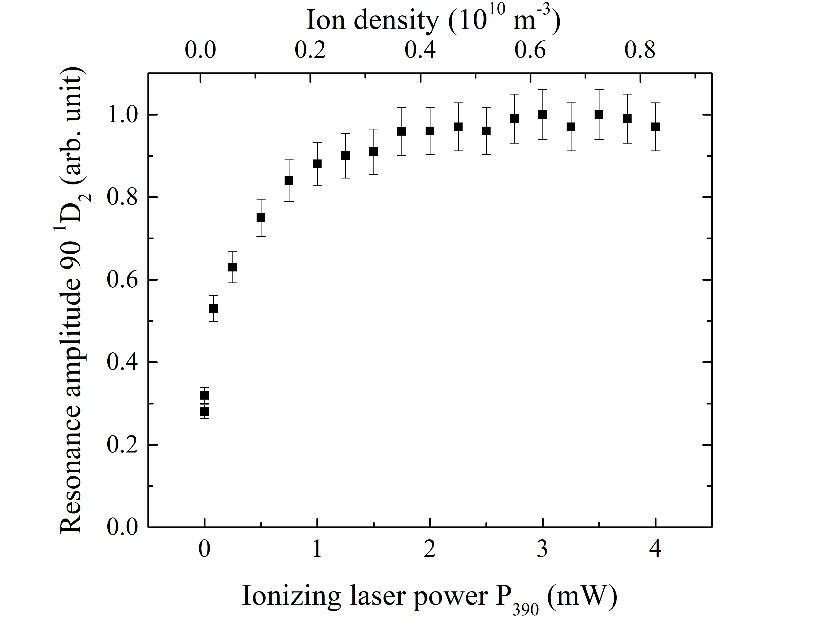
Dependence of the resonance amplitude at the 4s3d 1D2 – 90 1D2 Rydberg transition on the power P390 of the ionizing laser (λ = 390 nm) and the ion density in the UCP. The peak density of the neutral atoms is $n_a = 10^{15}$m-3.
B.B. Zelener, E.V. Vilshanskaya, S.A. Saakyan, V.A. Sautenkov, B.V. Zelener, V.E. Fortov
JETP Letters 113, Issue 2 (2021).
In the past few decades, the intensive development of angle-resolved photoemission spectroscopy (ARPES) made it possible to experimentally observe the electronic band structure for various classes of materials with a high instrumental resolution and in a wide binding energy range. The corresponding ARPES data are represents maps on which the electronic states are characterized by position in energy, in reciprocal space, width and intensity.
On the other hand, the improvement of theoretical methods for calculating electronic band structure also allows one to obtain the spectral function maps. For example, the density functional theory (DFT) and its combination with various methods take into account electronic interactions (for example, LDA+DMFT). This led to the need for a quantitative comparison of the theoretical and experimental electronic bands. For this, in the theoretical and experimental data, it is necessary to compare not only the qualitative energy position of the electronic bands, but also their relative intensities and widths.
In this work, a technique is proposed for taking into account a number of experimental details for theoretical spectral functions: the photoemission cross-section, experimental energy and angular resolutions, the photo-excited hole lifetime effects. The study was done on the high-temperature iron-based superconductors (NaFeAs and FeSe on a SrTiO3 substrate). It is shown that a significant share in the broadening of quasiparticle bands is associated precisely with taking into account the experimental details in the theory.
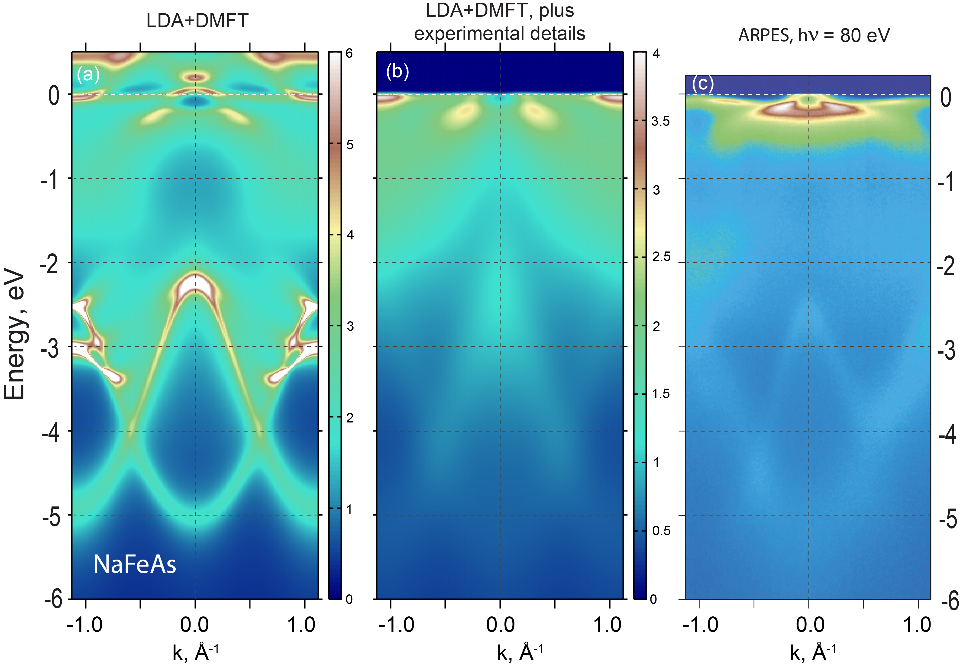
(a) LDA + DMFT spectral function for NaFeAs in the M-G-M direction, (b) taking into account the experimental details, (c) ARPES. Fermi level - zero energy (white dotted line).
I.A. Nekrasov, N.S. Pavlov
JETP Letters 113, issue 2 (2021)
A review is given of unusual many-particle effects discovered in strongly interacting two-dimensional electronic systems in quantizing magnetic fields in MgZnO/ZnO heterostructures. The studied two-dimensional systems have unique properties - strong Coulomb interaction, characterized by the high values of the Wigner-Seits parameter rs~5-10 and, at the same time, high low-temperature mobilities, which enable detecting numerous many-particle effects. The properties of collective electronic excitations in the regime of the integer quantum Hall effect are investigated by the method of inelastic light scattering. Many results concerning both the structure of the ground state and many-particle contributions to the energy of collective excitations go far beyond the well-known concepts of the microscopic structure of quantum Hall states. Despite the absence of a rigorous theory of 2D electron systems for rs>>1, the observed effects can be described in terms of Fermi-liquid quasiparticles with renormalized parameters. The phenomena of renormalization of the quasiparticle effective mass, its spin susceptibility, ferromagnetic instabilities at even filling factors, as well as the strongest renormalization of their exchange interaction are studied experimentally. The observed effects are quantitatively described by calculations performed using the method of exact diagonalization of the energy spectrum, which takes into account the Coulomb mixing of Landau levels . The results of the analysis allow to reveal the characteristics of Fermi-liquid quasiparticles, smeared across multiple Landau levels and to probe their Hall quantization (see the figure).
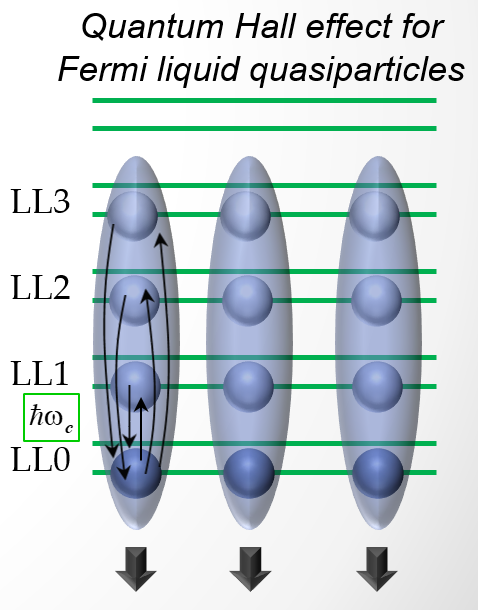
A.B. Vankov and I.V. Kukushkin
JETP Letters 113, issue 2 (2021)
Seven years ago, IceCube neutrino telescope has discovered neutrinos of Peta-electronvolt energies coming from yet unidentified astronomical sources. Active Galactic Nuclei (AGN) powered by supermassive black holes ejecting relativistic jets are considered as possible source of the IceCube astrophysical neutrino signal. Direct verification of this hypothesis is however difficult because of the low statistics of the neutrino signal and moderate angular resolution of the IceCube telescope.
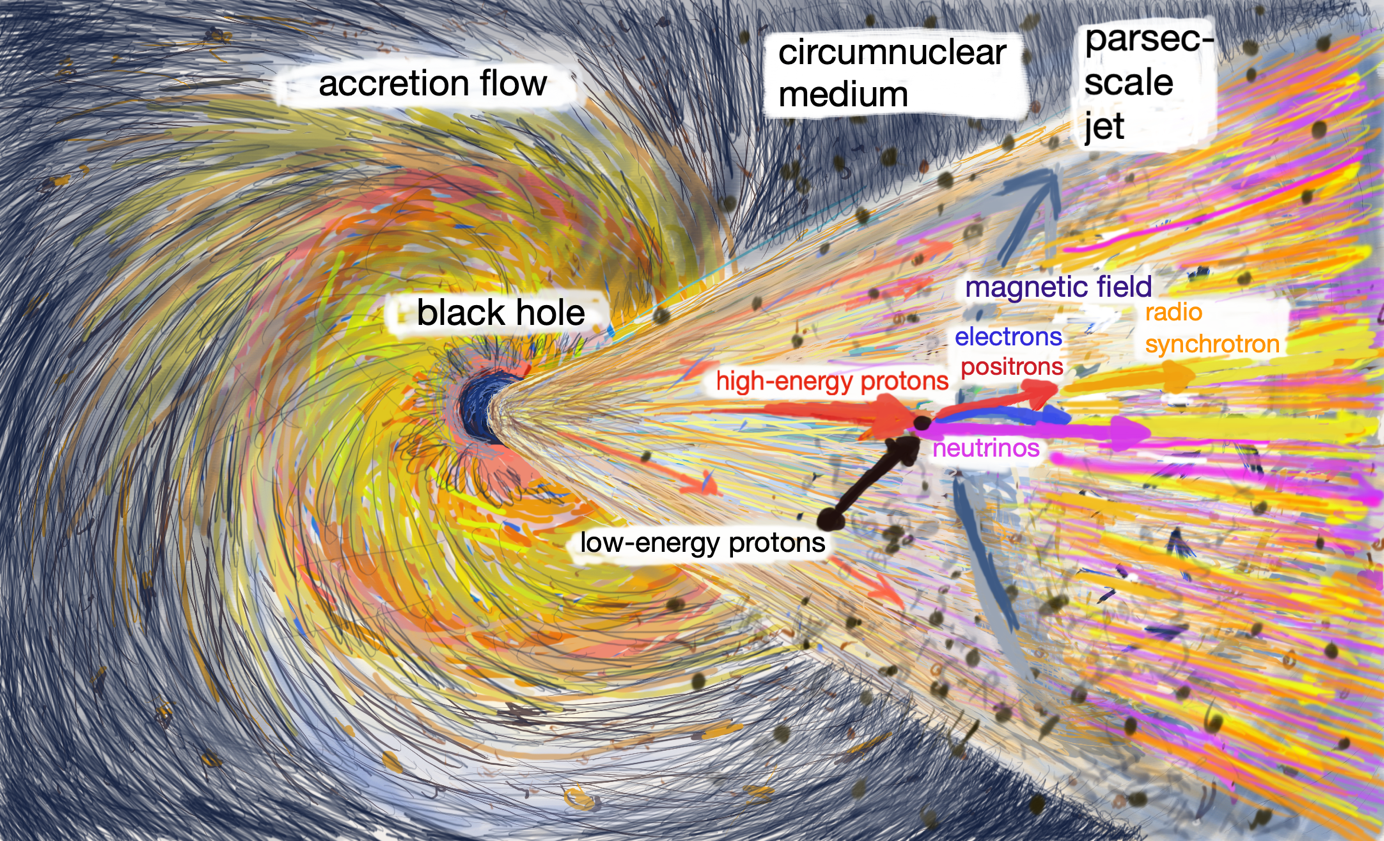
Interactions of high-energy protons and atomic nuclei that result in production of astrophysical neutrinos in AGN inevitably produce also gamma-rays, electrons and positrons that initiate electromagnetic cascade releasing its energy into Giga-electronvolt (GeV) to Tera-electronvolt (TeV) range. Thus, it is natural to expect that the sources of astrophysical neutrinos have GeV-TeV gamma-ray counterparts. However, contrary to expectations, arrival directions of astrophysical neutrinos detected by IceCube do not correlate with positions of brightest gamma-ray emitting AGN detected by Fermi LAT gamma-ray telescope. At the same time, surprisingly, recent analysis of correlation between neutrino arrival directions and positions of AGN brightest in the radio band by Plavin et al. (2020) has revealed significant correlation.
This is puzzling, because theoretical models of neutrino production in AGN typically assume that high-energy protons interact with ultraviolet photons produced by the hottest part of accretion flow onto the supermassive black hole, close to the AGN “central engine”. Its size is about the size of the Solar system, much smaller than that of the parsec-scale jets producing radio synchrotron emission. Moreover, the proton-photon reaction that can in principle produce both neutrinos and electrons / positrons has very high energy threshold. This reaction cannot directly produce electrons and positrons generating radio synchrotron emission.
The letter “Radio-to-gamma-ray synchrotron and neutrino emission from proton-proton interactions in active galactic nuclei” proposes a solution to these puzzles. High-energy protons in the AGN jet can efficiently interact on parsec-scale distances with low-energy protons from the circumnuclear medium. The energy threshold of proton-proton reaction that produces neutrinos, electrons and positrons is moderately low so that electrons with energies close to the threshold emit synchrotron radiation in the radio band. In this model the neutrino and radio fluxes are correlated because both are determined by the power of the primary proton beam reaching parsec-scale distances in the AGN jets.
A.Neronov, D. Semikoz
JETP Letters 113, issue 2 (2021)
The interfaces between superconductors (S) and ferromagnets (F) are known to be the origin of rich physics associated with the proximity effect. The exchange field inside the ferromagnets converts the spin-singlet Cooper pairs into the spin-triplet ones. Such unusual spin structure of superconducting correlations is responsible for the spatial oscillations of the Cooper pair wave function and a great variety of resulting interference phenomena.
Recently, it has become clear that the proximity effect also drastically modifies the electrodynamics of S/F structures. As an example, spin-triplet pairs can damp the usual diamagnetic Meissner response down to zero, and its vanishing was shown to be the hallmark for the emergence of the peculiar Fulde-Ferrell-Larkin-Ovchinnikov (FFLO) phase with the superconducting order parameter modulated in the plane of the layers [1, 2]. Another electromagnetic consequence of the proximity effect is the anomalous long-range transfer of the magnetic field from the ferromagnet to the superconductor even in the case when the F layer does not produce a stray magnetic field [3, 4]. This so-called electromagnetic proximity effect originates from the generation of the superconducting currents inside the F layer due to the direct proximity effect and the subsequent appearance of the compensating Meissner currents flowing in the S layer.
In this paper we review the recent results related to the physics of the in-plane FFLO states and electromagnetic proximity effect in S/F hybrids. Also we analyze the interplay between these two phenomena revealing through the boosting of the spontaneous magnetic field generated in the S layer due to the electromagnetic proximity effect in the vicinity of the phase transition from the uniform superconducting state to the in-plane FFLO phase.
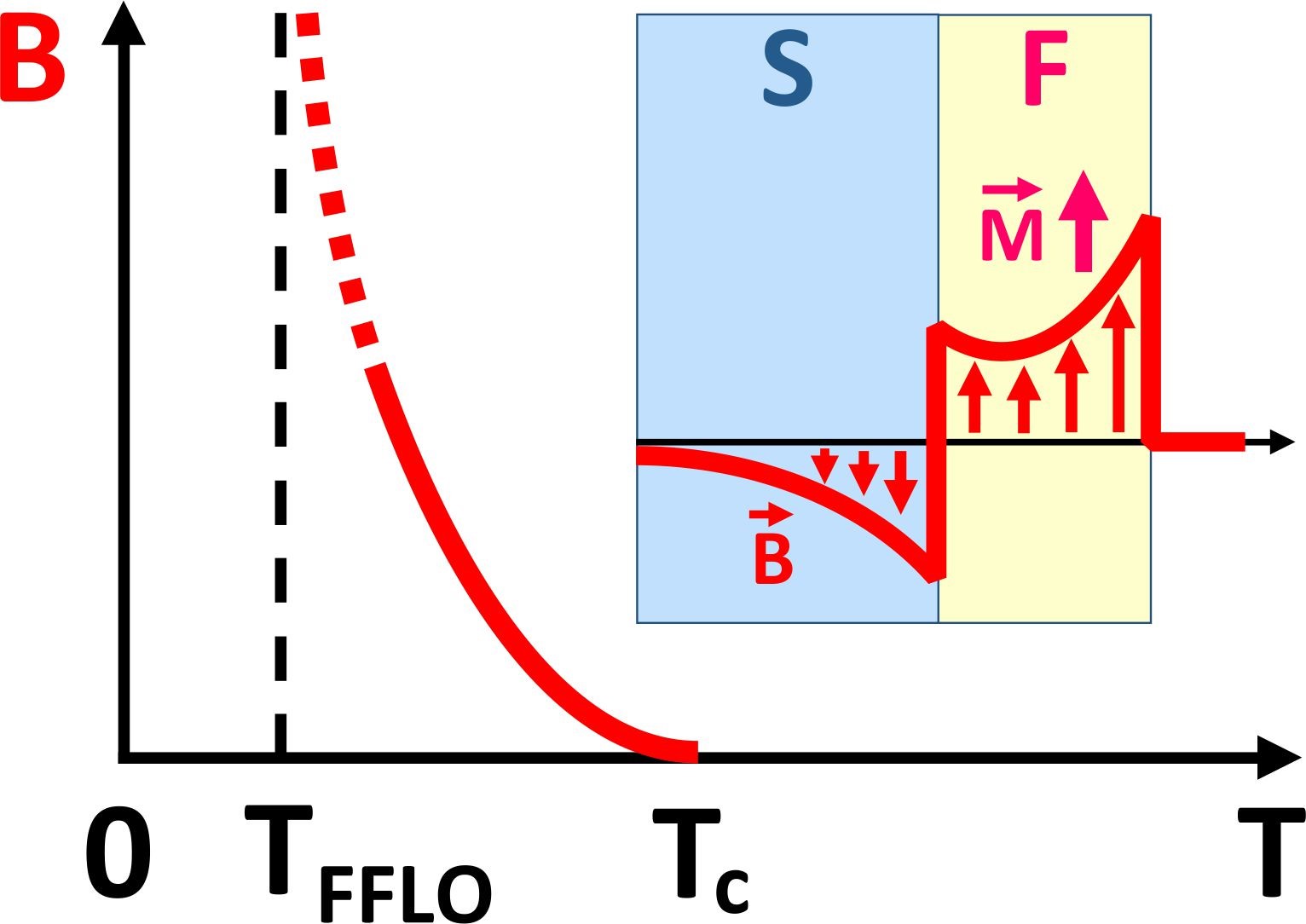
Leakage of the magnetic field from the ferromagnet to the superconductor due to the electromagnetic proximity effect and qualitative plot illustrating the increase in the amplitude of the spontaneous magnetic field when approaching the transition to the FFLO phase (with the decrease of temperature).
[1] S. Mironov, A. Mel’nikov, A. Buzdin, Phys. Rev. Lett. 109, 237002 (2012)
[2] S. V. Mironov, D. Yu. Vodolazov, Y. Yerin, A. V. Samokhvalov, A. S. Mel’nikov, A. Buzdin, Phys. Rev. Lett. 121, 077002 (2018)
[3] S. Mironov, A. S. Mel’nikov, A. Buzdin, Appl. Phys. Lett. 113, 022601 (2018)
[4] Zh. Devizorova, S. V. Mironov, A. S. Mel’nikov, A. Buzdin, Phys. Rev. B 99, 104519 (2019).
S. V. Mironov, A. V. Samokhvalov, A. Buzdin, A. S. Mel’nikov
JETP Letters 113, issue 2 (2021)
Half-metals are rather unusual and promising materials. The Fermi surface of a half-metal is completely spin-polarized. Namely, electronic states with only one spin projection value reach the Fermi energy. States with the other spin projection are pushed away from the Fermi level. This makes half-metals useful for spintronics. Typically, half-metallicity arises in strongly correlated electron systems, or when localized magnetic moments are present. We demonstrated that doping a density-wave insulator even in the weak-coupling limit may stabilize new types of half-metallic states, such as spin-valley half-metal and charge-density wave (CDW) half-metal.
In a simple model Hamiltonian describing two Fermi surface pockets (or valleys) with nesting, the electron-electron repulsion generates spin- or charge-density wave state, see Fig.1(a). If charge is added or removed from such a system, the situation becomes less clear-cut: several states with close energies are competing. Such possibilities as incommensurate density wave, electronic phase separation, stripes, etc. are discussed in the theoretical literature. We demonstrate that yet another type of many-body state is available. In the doped system, the two-valley Fermi surface emerges. One valley is electron-like. It is composed mostly of states of electron band, with spin σ. Another valley is hole-like, composed predominantly of states from hole band, with spin σ'. These Fermi surface valleys have half-metallic character: the states in electron band with spin -σ, as well as states in hole band with spin –σ', do not reach the Fermi level and have no Fermi surface.
Depending on the parameters, the spin polarizations of the electron-like valley and hole-like valley may be parallel (σ = σ') or antiparallel (σ = -σ'), see Fig.1(b,c). The former case is similar to the usual half-metal: quasiparticles at the Fermi surface are completely spin-polarized. In addition, the system exhibits a finite CDW order parameter. For this reason, we refer to such a state as the CDW half-metal. When σ = -σ', the total spin polarization averages to zero. It is proven, however, that in this situation, the so-called spin-valley polarization is nonzero. Thus, the state is called the spin-valley half-metal. The specific features of these half-metallic states are discussed. Namely, we demonstrate that the electric current can be accompanied by the transfer of spin or of the spin-valley quantum number. Such effects could be of interest for spintronics and pave the way to spin-valley-tronics. We also discussed the possibility of using the inelastic neutron scattering to detect the half-metallic states.
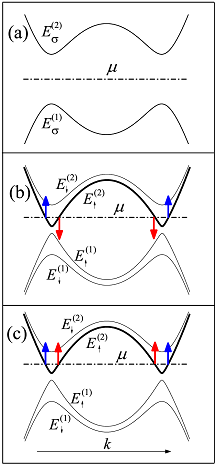
Band structure of (a) undoped density wave, (b) spin-valley and (c) charge density wave half-metals. Horizontal line shows the Fermi level, arrows indicate spin polarizations of the Fermi surface.
A.V. Rozhkov, A.O. Sboychakov, D.A Khokhlov and A.L. Rakhmanov and A.D. Kudakov
JETP Letters 112, issue 11 (2020)
The magnonic Bose condensed state was first discovered in superfluid 3He under magnetic resonance conditions. The repulsive interaction between magnons stabilizes this state. The transfer of magnetization by a magnon supercurrent was also discovered [1]. Quite similar phenomena were observed in a nonplanar magnetized film of yttrium iron garnet (YIG), but at room temperature. When the deviation of the magnetization in YIG is more than 3 degrees, the density of non-equilibrium magnons exceeds the critical one [2], and a magnon Bose condensate is formed. Due to the superfluidity of magnons, the BEC state can fill the entire sample and the angles of magnetization deviation exceed 20 degrees [3].
Magnon BEC was studied in a YIG film epitaxially grown on a gadolinium gallium garnet (GGG) plate 0.5 mm thick. The Gilbert attenuation determines the field shift of the BEC observation. It has been found to be highly frequency dependent. It increases significantly when the frequency matches the standing sound waves in the GGG (peaks A in Fig. 1). The magnetoelastic interaction excites phonons, which dissipate energy. Unexpectedly, we also detected antiresonant signals (dips B in Fig. 1). We can explain this by the coherent mediation of circularly polarized phonons, which return their angular momentum after being reflected from the other side of the GGG plate. This observation shows the coherent transfer of the angular momentum of phonons through non-magnetic material on a macroscopic distance.
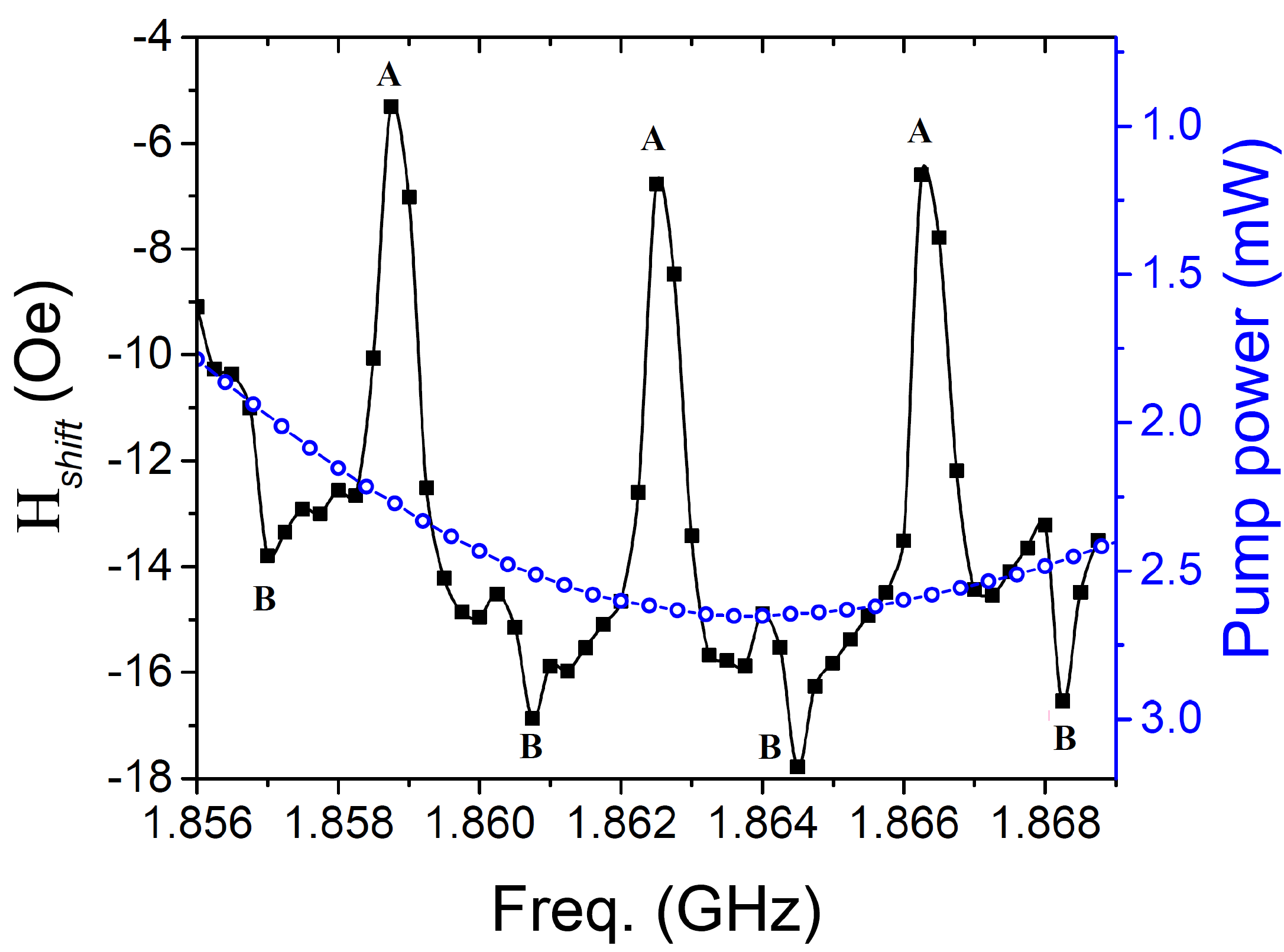
[1] G. E. Volovik, J. Low Temp. Phys., 153, 266 (2008)
[2] Yu.M.Bunkov, V. L. Safonov, J. Mag. Mag. Mat., 452 30–34 (2018)
[3] P. M. Vetoshko, G. A. Knyazev, A. N. Kuzmichev, A. A. Cholin, V. I. Belotelov, Yu. M. Bunkov, JETP Letters 112, 313 (2020).
P. M. Vetoshko, G. A. Knyazev, A. N. Kuzmichev, V. I. Belotelov, Yu. M. Bunkov
JETP Letters 112, issue11 (2020).
The ability to explain when and why an isolated quantum mechanical system can be accurately described with equilibrium statistical mechanics is one of the key challenges in modern statistical physics. Such description may be possible even for time-dependent Hamiltonians, and much attention has focused on the emergence of quasi-equilibrium states in many-particle periodically driven systems. Numerous approximate methods have been developed to describe dynamics of such systems, known as Floquet dynamics. Interesting results were previously obtained when the external driving frequency significantly exceeds the strength of the interaction in the system in frequency units (the averaging condition).
NMR in solids was one of the first areas where experimental and theoretical investigations of dynamics and thermodynamics in periodically driven systems were performed. The powerful experimental technique of NMR and relatively simple analytic tools allowed the creation of “spin alchemy” with very interesting results.
In this letter we work out a numerical method to investigate Floquet dynamics in the simplest multi-pulse NMR experiment in a system of 14 spins connected by dipole-dipole interactions. We discover that a quasi-thermodynamic equilibrium is established under the averaging condition. When this condition is not met, instead of a quasi-equilibrium state, we find that the polarization decays to zero.
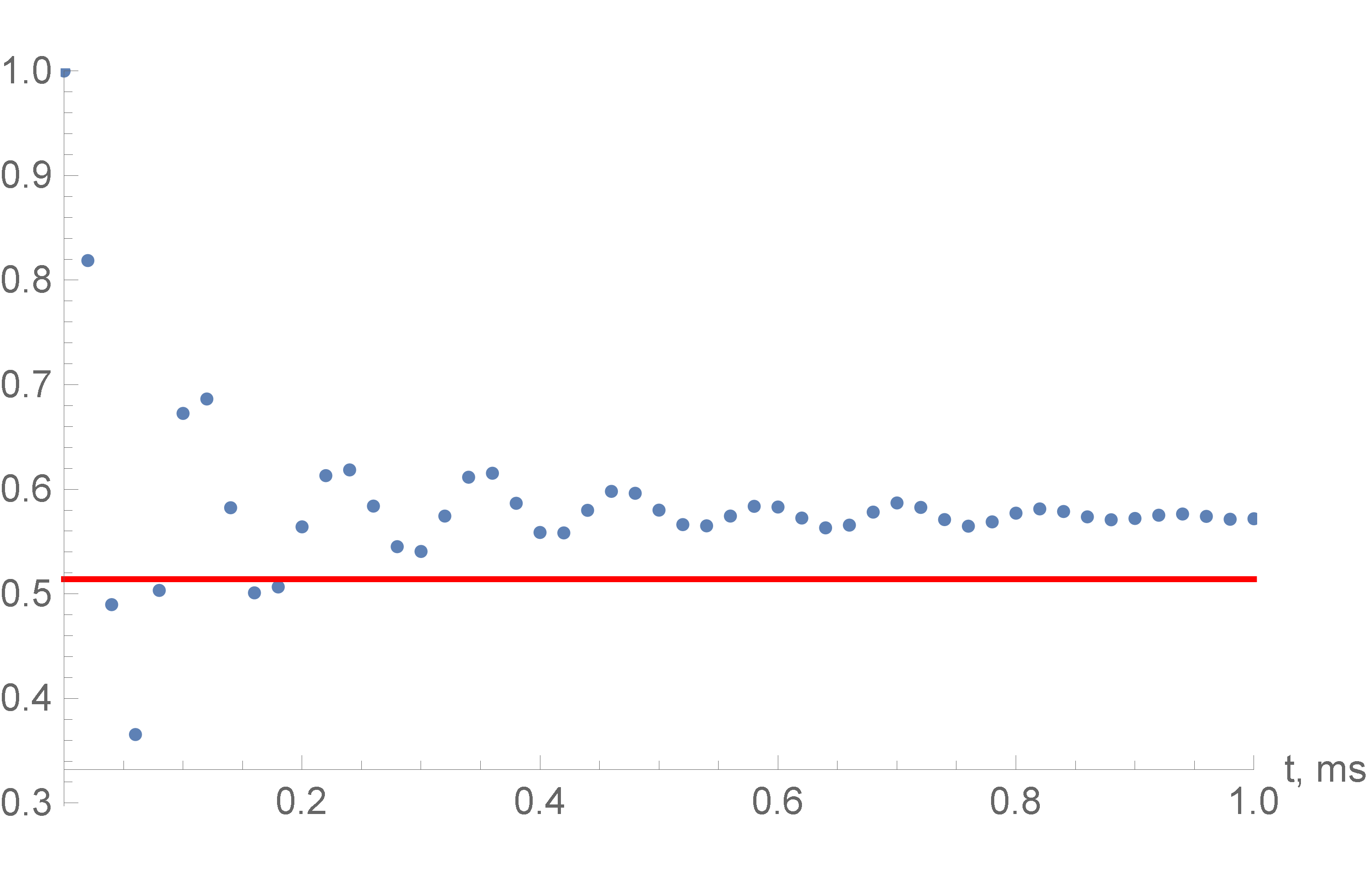
The decay of the polarization in multi-pulse NMR spin-locking with π/8 RF pulses. The initial polarization equals 1. The horizontal line is the thermodynamic equilibrium polarization.The number of the spins is 14. The averaging condition is satisfied.
G.A.Bochkin, S.G.Vasil’ev, A.V.Fedorova, E.B.Fel’dman
JETP Letters 112, issue 11 (2020)
The problem of searching new high-energy-density materials (HEDM) is very actual from both applied and fundamental points of view. Choosing nitrogen as a promising element for creating HEDMs have several reasons. Under normal conditions, nitrogen exists in the form of diatomic N2 molecules with a triple covalent bond, which is one of the strongest covalent bonds in nature, its energy is 4.9 eV/atom. The energies of double and single bonds for nitrogen are 2.17 eV/atom and 0.83 eV/atom, respectively. Those for nitrogen the sum of three single bonds energies is much less than energy of triple bond; therefore, single-bonded nitrogen crystal structures will store energy. At the same time, the release of energy is an environmentally friendly process.
In this article, the existence of a metastable, single-bonded crystalline nitrogen phase with symmetry P-62c is predicted theoretically. This phase is a direct-gap semiconductor and can store the largest amount of energy among all nitrogen crystals predicted to date, which are stable at low pressures. This structure of non-molecular nitrogen has all the necessary attributes of dynamic (in terms of the phonon spectrum) and mechanical (in terms of elastic moduli) stability of a bulk medium at pressures less than 40 GPa, including zero pressure. In the entire pressure stability range phase P-62c is metastable. For its synthesis, it is necessary to search new methods, for example, synthesis through excited states.
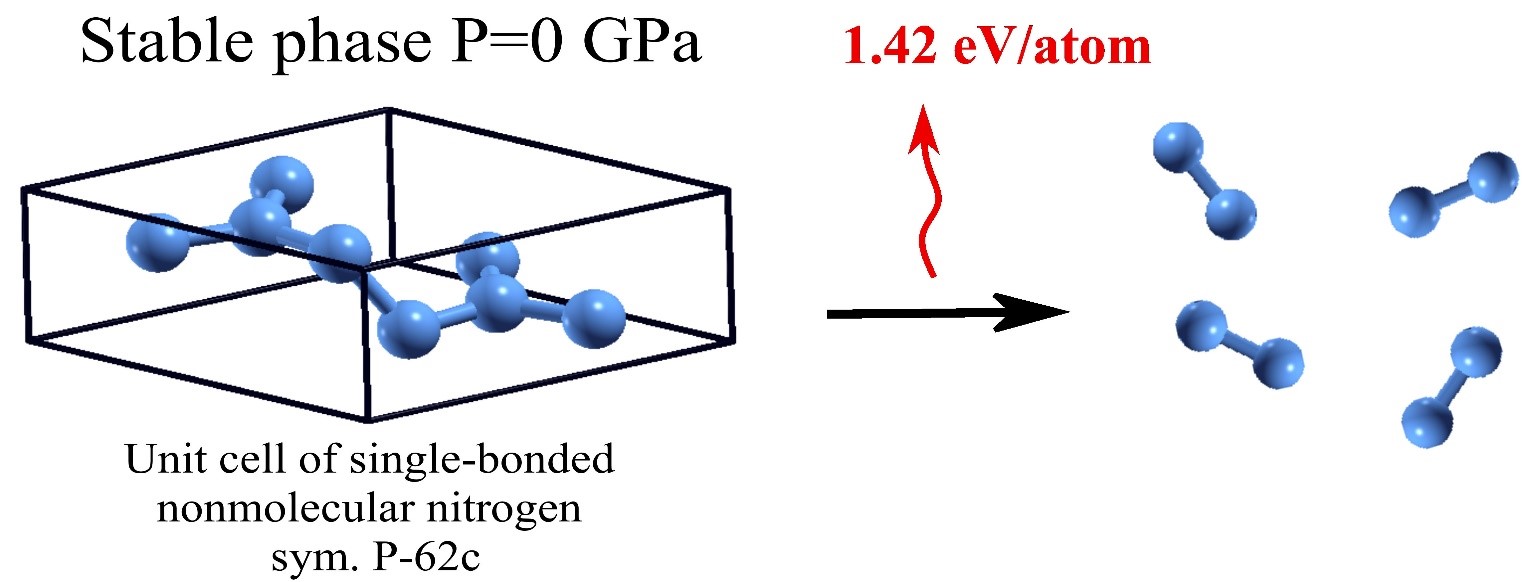
K.S.Grishakov and N.N.Degtyarenko
JETP Letters 112, issue 10 (2020)
After the discovery of Mott insulating states and superconductivity in the so-called magic angle twisted bilayer graphene in 2018, the study of this material became a hot topic in condensed matter physics. In single-particle approximation, the system under study has four almost flat almost degenerate bands near the Fermi level. The electron-electron interaction lifts this degeneracy stabilizing some order parameter in the system. The mottness of the ground state of the magic angle twisted bilayer graphene manifests itself in the sequence of conductivity minima observed for several doping levels.
The nature of the ground state of the magic angle twisted bilayer graphene is not yet known. Here, we assume that the emerging non-superconducting order parameter is a spin density wave, and study the evolution of such ordered state with doping. We show that in the range of electron densities, where the order parameter is nonzero, the homogeneous state of the system can be unstable with respect to the phase separation. Phases in the inhomogeneous state are characterized by an even number (n = 0, ±2, ±4) of electrons per a superlattice cell. This allows us to explain some features in the behavior of the conductivity of the system with doping. Thus, we are able to explain the fact that the conductivity minima, that could occur at doping levels corresponding to an odd number (n = ±1, ±3) of electrons per supercell, are absent in some samples under study (phase separation occurs) and are present in other samples (phase separation is suppressed by the long-range Coulomb repulsion).
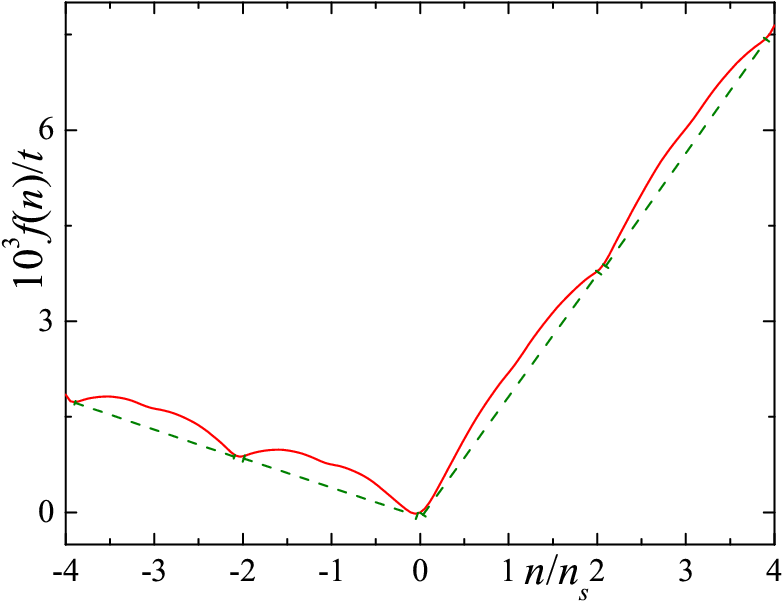
Free energy of the system as a function of doping. The solid (red) curve corresponds to the free energy of the homogeneous state. The energies of the inhomogeneous states obtained by the Maxwell construction are shown by dashed (green) lines
A.O. Sboychakov, A.V. Rozhkov, K.I. Kugel, and A.L. Rakhmanov
JETP Letters 112, issue 10 (2020)